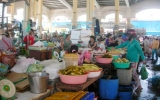Challenge and prospect of some export industries
Some the country’s key export staples are assessed to reach a good growth in 2012 and 2013. However, businesses involving in the staples have faced many difficulties. Apparel and timber processing are among of the key export staples.
According to experts, apparel industry remains growth with the rate of 25% in this year if efforts are done by the Government and businesses. Expectedly, it would have to achieve a growth rate of 25 per cent and total turnover of US$25 billion to reach its 2012 targets. At least US$19 billion of that total figure would have to come from exports.
 A production line at an apparel business in Binh Duong.
A production line at an apparel business in Binh Duong.
Many difficulties
According to Nguyen Van Tuan, vice general secretary of the Vietnam Textile and Apparel Association, one of the biggest problems facing the industry is the reliance on import materials. They include unbalance of structure and problem of production modes. The domestic apparel industry depends on import materials. Specifically, it still imports a great deal of raw materials. With a need of 400,000 tonnes of natural cotton per year, the industry receives only 3,000 tonnes or 0.75 per cent from domestic resources. About 400,000 tonnes of artificial fibres are needed, but domestic resources can provide only 120,000 tonnes. In addition, all equipment and parts needed in the textile industry are imported. Last year, enterprises in the apparel sector had to import 5.2 billion metres of fabric of the total 6 billion metres needed for production activities.
The domestic textile and apparel industry has about 4,000 enterprises, 650 of which are foreign-invested. Most foreign-invested enterprises use original branding manufacturing (OBM), or Original Designing Manufacturing (ODM), while domestic enterprises choose the mode of Cut/Make/Trim (CMT). Because of this method, Vietnamese companies have been unable to directly export their products and have had to ask for assistance from middlemen. As a result, profits have dropped.
In addition, the domestic textile and apparel industry has about 4,000 enterprises, only a few of them has trademarks. They include An Phuoc, Viet Tien, Nha Be, Phong Phu, Viet Thang and so on.
Distribution system should be reinforced
Many ideas said that the domestic market is considered as the first factor to help the local apparel industry overcome difficulties.
Accordingly, to get the proposed goals, businesses have to focus on expanding, building and reinforcing distribution system. Especially, businesses should pay attention to developing some Vietnamese trademarks in neighboring markets such Laos, Cambodia, Myanmar and so on and concentrating on original branding manufacturing (OBM), or Original Designing Manufacturing (ODM).
It is hoped that 2013 will reap many successes because of recovery of the world economy and signing of the Trans-Pacific Partnership Agreement (TPP). According to economic experts, this will be a crucial impetus to spur development of apparel industry.
The industry's growth rate is targeted to be 25 per cent in 2013 and 15 per cent in 2014 and 2015, with total turnover estimated at US$31.25 billion, US$36.94 billion and US$42.48 billion, respectively.
At present, the Government has positively negotiated to soon reach bilateral agreements with Japan, EU and especially join in TPP. Experts added that domestic apparel businesses should expand market, build and reinforce distribution system and urge investment in the industry to take advantage of chances of TPP.
Reported by K.Tan – Translated by A.C
 Fiscal space and neo momentum created for enterprises
Fiscal space and neo momentum created for enterprises
 Provincial leader receives delegation from Da Nang city’s People's Committee
Provincial leader receives delegation from Da Nang city’s People's Committee
 Entrepreneurs pioneering in joining forces with Binh Duong for development
Entrepreneurs pioneering in joining forces with Binh Duong for development
 Investment attracted, development of trade and services elevated
Investment attracted, development of trade and services elevated
 AI - A trend to support e-commerce businesses
AI - A trend to support e-commerce businesses
 Private economic sector joins up developing Binh Duong
Private economic sector joins up developing Binh Duong
 Enterprises resuming operations up 25% in nine months
Enterprises resuming operations up 25% in nine months
 Bright prospects for exports to set new record in 2024: Experts
Bright prospects for exports to set new record in 2024: Experts
 Steps for green development strategy concretized
Steps for green development strategy concretized
 Phu Giao bound for sustainable development
Phu Giao bound for sustainable development







